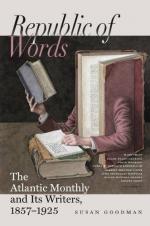Brigham Young perceives this inevitable advance of Christian civilization toward his stronghold, as clearly as the most unprejudiced spectator. No one is better aware than himself, that, if the great industrial conception of the age, the Pacific Railroad, shall ever begin to be realized, the first shovelful of dirt thrown on its embankments will be the commencement of the grave of his religion and authority. Among the projects with which his brain is busy is that of yet another exodus; and it must be undertaken speedily, if at all,—for a generation is growing up in the Church with an attachment for the land in which it was reared. The pioneers of the faith, who were buffeted from Ohio to Missouri, from Missouri to Illinois, and from Illinois to the Rocky Mountains, are dwindling every year. Their migrations have been so various, that no local sentiment would influence them against another removal. Such a sentiment, if it exists at all among them, is not for Utah, but for Missouri, where they believe that the capital will be founded of that kingdom in which the Church in the progress of ages will unite the world. They dropped upon the shores of the Salt Lake in 1847, like birds spent upon the wing, only because they could not fly farther.
Two regions have been suggested for the ultimate resort of the Mormons: one, the Mosquito Coast in Central America; the other, the Island of Papua or New Guinea, among the East Indies. During the winter, while the army lay encamped at Fort Bridger, Colonel Kinney, the colonizing adventurer, endeavored to communicate from the East to Brigham Young an offer to sell to the Church several millions of acres of land on the Mosquito Coast, of which he purports to be the proprietor. His agent, however, reached no farther than Green River. But during the spring of 1858, other agents, dispatched from California, were more successful in reaching Salt Lake Valley. They were hospitably received by the Mormons, but Young declined to enter into the negotiation. The other scheme—that for an emigration to Papua—originated at Washington during the same winter. It was eagerly seized upon by Captain Walter Gibson, the same who was once imprisoned by the Dutch in Java. He put himself into communication on the subject with Mr. Bernhisel, the Mormon delegate to Congress, who appeared to regard the plan with favor. After it was developed, as a step preliminary to transmitting it to Utah for consideration, Mr. Bernhisel waited upon the President of the United States in order to ascertain whether the cooperation of the National Government in the undertaking could be expected. The reply of Mr. Buchanan was fatal to the project, which he discountenanced as a vague and wild dream.




